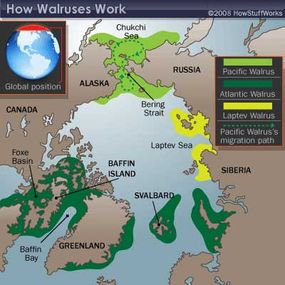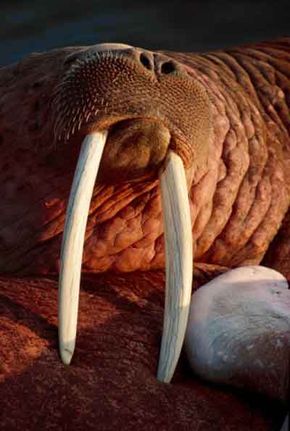Walrus Classification and Body Plan
Walruses are the second largest animal belonging to the order Pinnepedia, which also includes seals and sea lions. Of these animals, only the elephant seal can grow larger than the walrus. Walruses are also the only member of the order to possess tusks -- two especially long upper canines that can reach lengths of 3 feet (0.91 meters) and weigh 12 pounds (5.4 kg). In fact, the walrus's family name, Obodenidae, means tooth-walker in Greek, referring to the way walruses pull themselves up out of the water by hooking their long tusks into the ice.
You might assume walruses use their tusks as weapons, but primarily they use their tusks as tools and for establishing dominance. When males do get feisty, the especially thick skin around their neck and shoulders protects them from sharp jabs. In addition to using their tusks to haul themselves out of the water, walruses also use them when underwater to break breathing holes in the ice. And they may even hook the tusks over the ice like clothes hangers in order to take a break from swimming. Both the males and females have tusks, but the males' are longer, straighter and stronger, and may continue to grow for up to 15 years [source: Burns].
Advertisement
Walruses are generally a darkish brown color and have large, round bodies. They appear relatively clumsy on land but move easily through the water, where they spend two-thirds of their lives. Walruses have four flippers with rough bottoms to help provide traction on the slippery snow and ice. To move on land, they turn their two front flippers at 90-degree angles to their body and flap their two rear flippers directly underneath their pelvis. In the water, they can reach speeds up to 21.7 mph (35 kph). A walrus's front flippers are used for steering and its two hind flippers alternate strokes to propel the walrus through the water at an average of 4.3 mph (7 kph) [source: Burns].
The two walrus subspecies -- the Atlantic walrus and the Pacific walrus -- are geographically and reproductively isolated, meaning they do not interbreed or interact in any way. The two subspecies are similar except for size.
- Male Pacific walruses usually grow to between 9 and 12 feet (2.7-3.6 m) and weigh between 1,764 pounds and 3,748 pounds (800-1700 kg). Females grow to lengths between 7.5 feet and 10 feet (2.3-3.1 m) and weigh between 400 pounds and 1,250 pounds (882kg-2756 kg).
- The Atlantic males are a bit smaller at 9.5 feet (2.9 m) and 2,000 pounds (908 kg). Females are shorter but fatter at about eight feet (2.4 m) and 1,750 pounds (794 kg) [source: Burns].
Walruses are located throughout the arctic region. The Pacific walrus is found in the Bering, Chuckchi and Laptev seas of the Pacific Ocean. The Atlantic is found in the Atlantic Ocean primarily along the northeast coasts of Canada and in Greenland. Roughly 250,000 walruses exist today; 200,000 of these are Pacific stock [source: Burns]. As you might expect, more is known about the more prevalent Pacific walrus. This is partly due to funding issues, but also because of sheer numbers.

On the next page, you'll learn how a walrus's mustache can supplement its eyes and why its feeding habits might make it a good contender in a competitive eating contest.
